Creativity meets culture: Uplifting Asian & Asian American artists
Through the Thrivent Art Collection, we acknowledge and honor the cultural and creative contributions made by Asian and Asian American artists. Learn more about a few Asian and Asian American artists and their incredible work, featured in the Thrivent Art Collection.
Wing Young Huie (Chinese American, b. 1955)
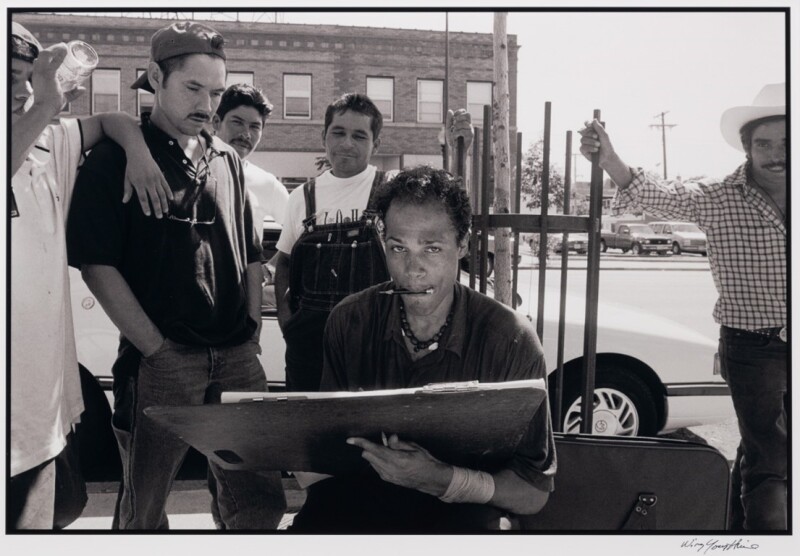
© 2020 Wing Young Huie
Internationally recognized, Twin Cities-based photographer Wing Young Huie is best known for his projects that engage with the local community. Born in Duluth, MN to a Chinese American immigrant family, Huie worked as a journalist before pivoting his interest and talent toward photography. Lake Street USA is a collection of nearly 700 photographs the artist shot between 1997 and 2000. Drawn to the Lake Street neighborhoods for their socio-economic, ethnic, and cultural diversity, Huie photographed thousands of residents for this comprehensive project, often conducting interviews with his subjects. Lake Street USA was realized as an extraordinary public art project when the artist transformed a six-mile section of Lake Street into an art gallery of sorts, by displaying hundreds of images of those who live and work in the area.
This image from the series captures a fellow artist at work. Like most of Huie’s work, this photo is a snapshot of a moment—a slice of daily life from a particular time and place. Like any snapshot or moment, it belongs to a longer narrative. Who are the individuals standing behind the artist? Perhaps they are friends, family members, or passersby on Lake Street. The draughtsman’s piercing gaze confronts us directly. It feels as though we are the subject of his work. Then we remember that this is a photograph. He is peering not at us, but at the photographer’s camera lens. In this moment, he and Huie are both artist and subject.
Barbara Takenaga (American, b. 1949)
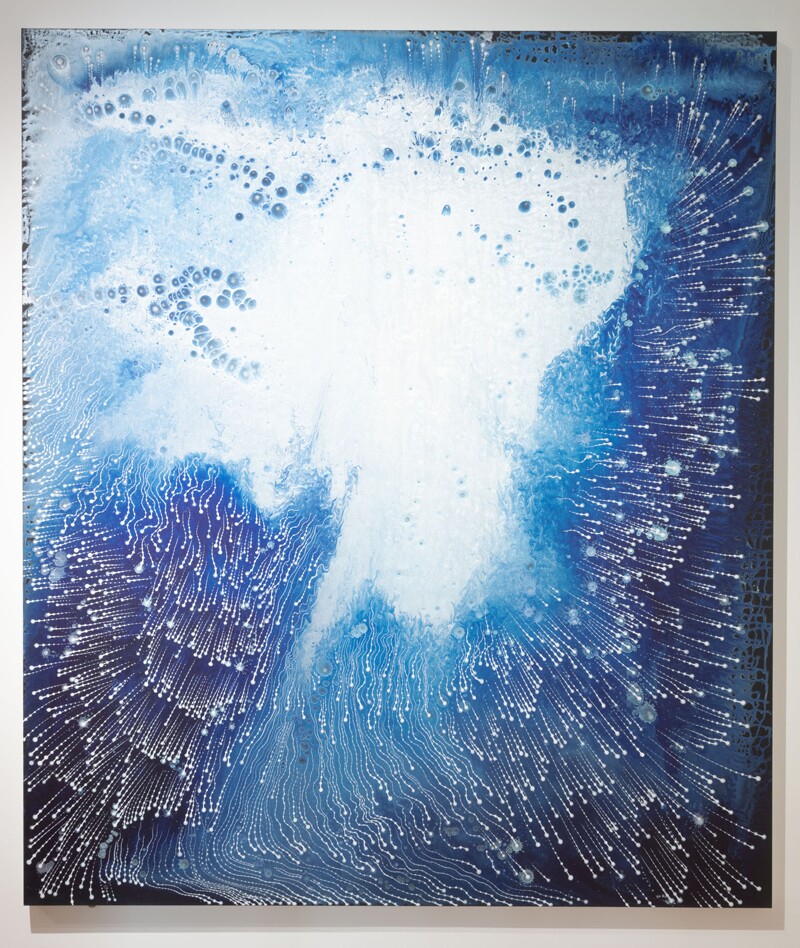
© 2020 Barbara Takenaga; Courtesy of the artist and DC Moore Gallery, New York.
Do you see an entire galaxy, or feel like you’re looking at living organisms through a microscope?
Barbara Takenaga combines scientific inquiry and abstracted imagery reminiscent of nature in her work to evoke momentum and magnetism. Takenaga improvises by pouring paint onto the canvas, allowing unpredictable areas of color to appear. Then, she adds pattern and form to create immersive color and swirling energy. Takenaga’s imagery offers a compelling mix of ordered detail and free-flowing abstraction.
Takenaga was born and raised in Nebraska. She has expressed that her Japanese heritage comes through her work more as time goes on. She has always had an affinity toward Eastern art and pattern but feels that her Japanese background and its influence was “submerged,” or coded, in the beginning of her career. In her current work, certain aspects of Japanese culture have been brought further to the forefront, in her art and mind. While this influence of Japanese culture is present in Takenaga’s work, she has reflected that her primary motivations as an artist involve her identity as a woman, and as a process-oriented abstract artist.
George Miyasaki (Japanese American, 1935-2013)
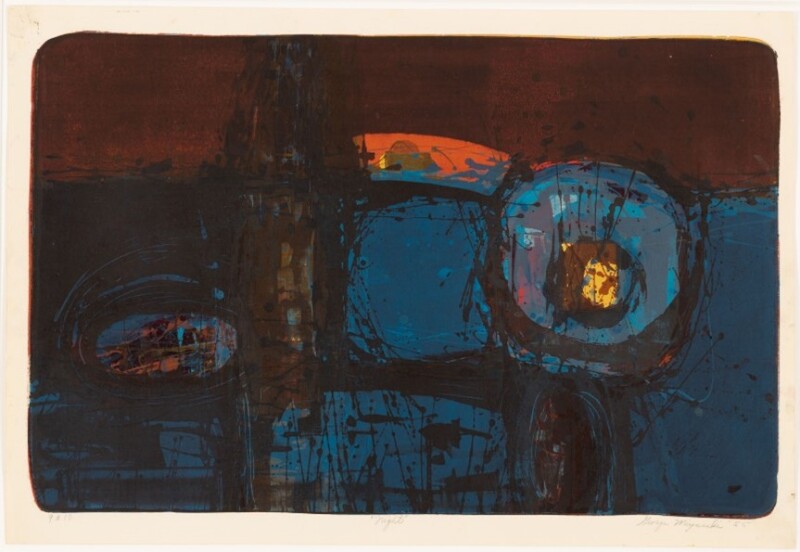
© George Miyasaki; Courtesy of the estate of the artist and RYAN LEE Gallery, New York.
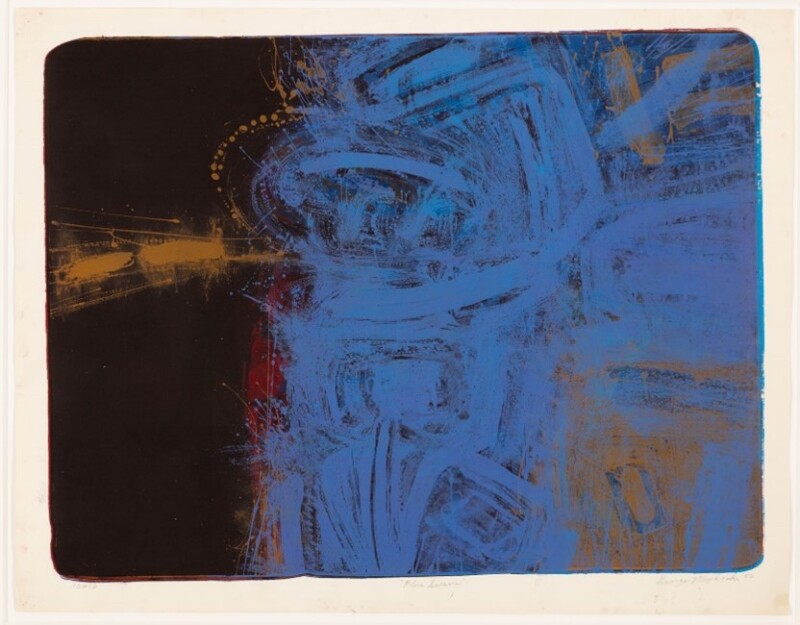
© George Miyasaki; Courtesy of the estate of the artist and RYAN LEE Gallery, New York.
George Miyasaki, an admired artist of the late 1950s and early 60s, is known for his abstract expressionist paintings and luminous prints. Despite Miyasaki’s role as a key figure in the influential San Francisco Bay Area arts community of the mid-20th century, his legacy is only recently beginning to receive due recognition. During this period of artistic exploration and growth for modern American art, artists of color faced additional challenges to have their work widely exhibited and its importance acknowledged.
Miyasaki was born in Hawaii in 1935 to Japanese parents. In 1953, Miyasaki moved to Oakland, California at the urging of his high school art instructor to study art. The two works by Miyasaki in the Thrivent Collection are both early-career lithographs, made while he was still in college in the mid-1950s. Night and Blue Serene demonstrate the randomness of his markings and the gorgeous texture he achieved by layering soft shapes and forms over fields of color. Choosing to evoke the natural world through abstract, spontaneous gesture was a different approach than many other abstract expressionist artists at the time, who instead sought to express their own inner psychology. Miyasaki prided himself on not following fads or the current trends in art. Miyasaki’s early printmaking was criticized at first for being “too painterly,” but later was celebrated for introducing brushwork in his prints.
By taking risks and following his own path, Miyasaki remained an eminent figure in California printmaking for half a century. In the following decades, Miyasaki experimented in pop art, minimalism, and began incorporating geometric and calligraphic forms into his work. Miyasaki’s work cannot be defined by one artistic movement.
Yoonmi Nam (Korean, b. 1974)
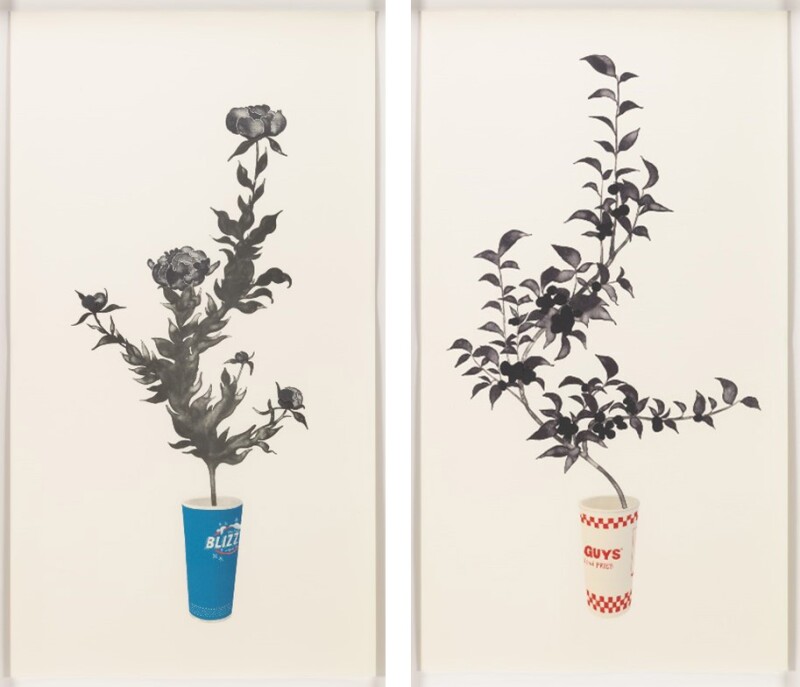
© 2018 Yoonmi Nam
Born and raised in Seoul, South Korea, Yoonmi Nam has lived in Canada, Japan, and currently resides in the United States, working as a printmaker and a university professor in Kansas. Her work considers cross-cultural experiences and a sense of transience through everyday objects and occurrences.
She explores the tension and dialogue between the disposable and impermanent nature of material objects—including their persistence and reusability. Simple floral arrangements, placed in various disposable objects, are a recurring motif in the artist’s original prints. In Blizz and Guys and Fries, flowering leafy branches are placed inside fast food paper cups that serve as make-shift vases for the elegant arrangement. Like the disposable cups, the plants carry a sense of impermanence—how long will they thrive in these containers? Nam emphasizes the contrast between organic and human-made materials by rendering the flowers in monochromatic gray tones and reserving a full color treatment for the restaurant cups and their emblazoned logos.
These playfully nostalgic works also recall ikebana, the Japanese art of flower arranging that can be traced back to the 6th century. In Blizz and Guys and Fries, Nam connects this Japanese artform with objects indicative of contemporary American culture. The foreign and the familiar are enmeshed for Nam, and through her art she creates imaginative spaces where different worlds co-exist.
